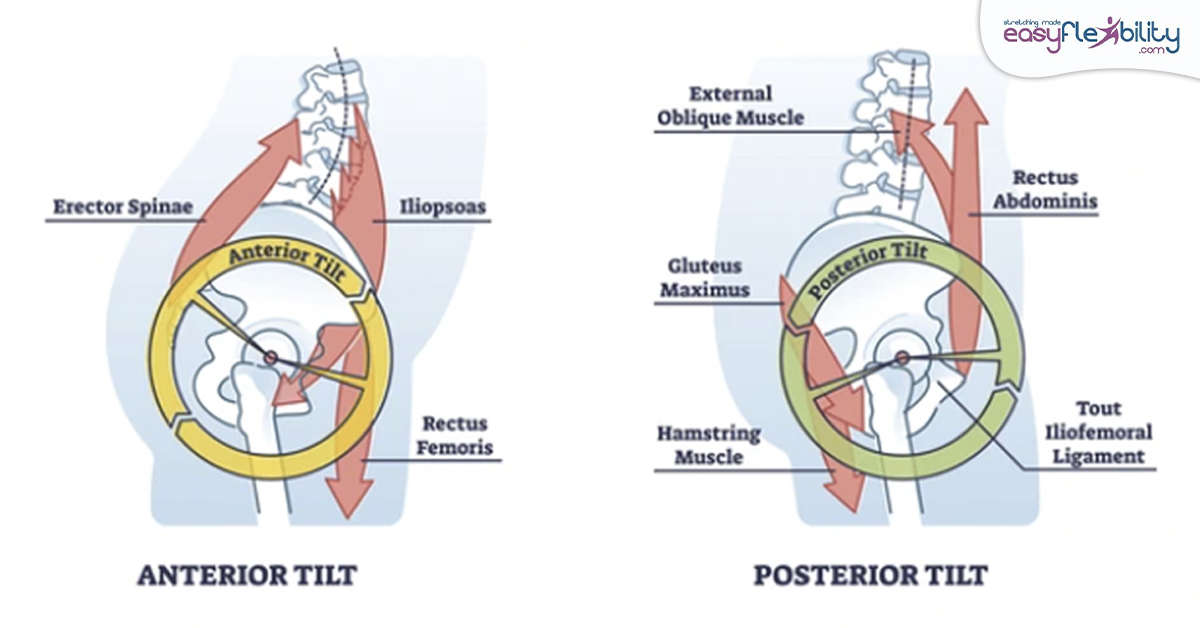Unlocking Flexibility: Navigating Anterior vs. Posterior Pelvic Tilt
May 14, 2024

Unlocking the Secrets of Pelvic Tilt: Anterior vs. Posterior and Beyond - Discover the Unique Benefits of the Anterior Pelvic Tilt Program!

During my college years, the emphasis was on maintaining a neutral pelvic position, avoiding extreme forward or backward tilts, to prevent injuries and enhance athletic capabilities.
This philosophy extended to addressing exaggerated conditions, such as a pronounced anterior pelvic tilt or excessive lordosis, characterized by a significant curve in the lower back. The goal was to reduce this curvature.
Conversely, individuals with a flat lower back, lacking curvature, or those with a posterior pelvic tilt, where the pelvis tucks under rather than pointing backward, were encouraged to increase their lordosis or improve their anterior pelvic tilt. This approach is widely adopted by many.
This philosophy extended to addressing exaggerated conditions, such as a pronounced anterior pelvic tilt or excessive lordosis, characterized by a significant curve in the lower back. The goal was to reduce this curvature.
Conversely, individuals with a flat lower back, lacking curvature, or those with a posterior pelvic tilt, where the pelvis tucks under rather than pointing backward, were encouraged to increase their lordosis or improve their anterior pelvic tilt. This approach is widely adopted by many.

What is the difference between anterior and posterior pelvic tilt?
Understanding the difference between anterior and posterior pelvic tilt can be confusing for beginners. Let's clarify:
- **Anterior Pelvic Tilt**: The top of the pelvis tilts forward.
- Tight lower back muscles
- Tight hip flexors
- Weak hamstrings
- Weak core flexors
- **Posterior Pelvic Tilt**: The top of the pelvis tilts backward, with the tailbone tucked under.
- Tight hamstrings
- Tight abdominal muscles
- Weak or inactive hip flexors
- Weak or inactive low back muscles
If you're considering our programs and unsure which to choose:
- **Anterior Pelvic Tilt Program**: Ideal for those with an anterior pelvic tilt looking to straighten the back slightly.
- **Posterior Pelvic Tilt Program**: Suitable for individuals with a posterior pelvic tilt aiming to increase the curve in their lower back.
- **Anterior Pelvic Tilt**: The top of the pelvis tilts forward.
- Tight lower back muscles
- Tight hip flexors
- Weak hamstrings
- Weak core flexors
- **Posterior Pelvic Tilt**: The top of the pelvis tilts backward, with the tailbone tucked under.
- Tight hamstrings
- Tight abdominal muscles
- Weak or inactive hip flexors
- Weak or inactive low back muscles
If you're considering our programs and unsure which to choose:
- **Anterior Pelvic Tilt Program**: Ideal for those with an anterior pelvic tilt looking to straighten the back slightly.
- **Posterior Pelvic Tilt Program**: Suitable for individuals with a posterior pelvic tilt aiming to increase the curve in their lower back.

Transform Your Posture: Say Goodbye to the 'No Butt Syndrome' and Hello to a Stronger, Curvier Lower Back!
Our program revitalizes your figure by restoring the natural curve of your lower back, reducing stress and danger during everyday activities like squatting and lifting. With Zaichik Stretching and unique posture strengthening, not only will your back thank you, but you'll also see your butt reappear, stronger and more defined than ever!"

Motivations for Deliberately Accentuating Pelvic Tilt
Many people aren't aiming to neutralize their pelvic tilt; rather, they wish to enhance it further. These individuals already have an anterior pelvic tilt but want to accentuate it even more. Instead of diminishing it, their goal is to increase the curvature of their back, making it more pronounced. But why? There are several reasons for this, and I'll share the top three with you.

#1: Side Split with Toes pointed forward:
For example, consider trying to achieve a side split with your toes pointing straight ahead. There's a limit to how much you can rotate your hips forward before they won't move any further, and yet your feet may not be flat on the ground.
By hyperextending your lower back, you can perform a side split or back split with your toes pointing forward instead of upwards. Individuals aiming to accomplish this type of split frequently utilize our Posterior Pelvic Tilt Correction program to accentuate the curve in their lower back.
By hyperextending your lower back, you can perform a side split or back split with your toes pointing forward instead of upwards. Individuals aiming to accomplish this type of split frequently utilize our Posterior Pelvic Tilt Correction program to accentuate the curve in their lower back.

#2: Enhanced Glutes (Bigger Butt)
Additionally, there are individuals who aim to accentuate the curve in their lower back to create the appearance of larger glutes, which they find more appealing for their specific needs. This could be, for instance, a model showcasing certain outfits, or a pole dancer adopting specific poses who desires an exaggerated lordosis. Often, people looking to enhance the appearance of their glutes opt for our Posterior Pelvic Tilt Correction program to achieve this effect.

#3: Athletes aiming to enhance their sprinting performance.
Lastly, we've had interactions with athletes, including sprinters, who were uncertain whether to choose our Anterior Pelvic Tilt program or the Posterior Pelvic Tilt program to enhance the curve of their lower back. They were advised by their coaches that a more pronounced anterior pelvic tilt could lead to greater power and explosiveness in their sprinting. After participating in our Posterior Pelvic Tilt Correction program, they reported improvements in their sprinting performance.
These instances are just a few unconventional ways our program has been utilized. Our program is designed to help increase your anterior tilt if you're experiencing a posterior tilt, allowing you to slightly or significantly enhance the curve of your lower back.
If you're still unsure which program best suits your needs, don't hesitate to reach out for guidance by clicking here. We're eager to help you select the ideal program to meet your strength and flexibility goals.
These instances are just a few unconventional ways our program has been utilized. Our program is designed to help increase your anterior tilt if you're experiencing a posterior tilt, allowing you to slightly or significantly enhance the curve of your lower back.
If you're still unsure which program best suits your needs, don't hesitate to reach out for guidance by clicking here. We're eager to help you select the ideal program to meet your strength and flexibility goals.

About the Author:
Paul Zaichik is an Exercise Science Expert, author of multitude of books, and the creator of Zaichik Stretching Technique (formerly known as Kinesiological Stretching Technique). His specialty is flexibility training as well as body weight conditioning. His innovative method is designed to have maximum carry over into specific athletic techniques. Paul is the author of books and DVD’s on the topic of flexibility, martial arts and bodyweight training. Over the years, Paul Zaichik has worked with a variety of individuals including athletes, entertainers, and military personnel. His ElasticSteel Method of Athletic Conditioning programs, EasyFlexibility Programs and Zaichik Stretching Techniques are used world wide by both professional and amateurs with great success.


